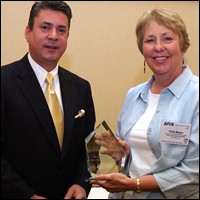Interview with Fort Collins Utilities, Winner of the WPA/APPA Public Power Wind Pioneer Award 2004
Oct. 26, 2004

Patricia Bigner, Fort Collins Utilities, accepted the 2004 Wind Powering America/American Public Power Association Public Power Wind Pioneer Award from Phil Dougherty, national coordinator of the Wind Powering America program.
On October 26, the U.S. Department of Energy's (DOE's) Wind Powering America program and the American Public Power Association presented Fort Collins Utilities with the 2004 Public Power Wind Pioneer Award for vision, leadership, and outstanding community support for renewable energy.
Q. Tell us a little about Fort Collins Utilities' wind program. How did Fort Collins become involved with renewables and wind in particular?
A. In April of 1998, Fort Collins Utilities became the first utility in Colorado and among the first in the nation to deliver wind energy for residential and business subscribers. The wind energy is provided by Platte River Power Authority, Fort Collins' wholesale electricity provider, from the Medicine Bow Wind Project near the town of Medicine Bow, Wyoming, and the Pleasant Valley Wind Energy Facility in southwest Wyoming. Subscribers purchase wind energy for an additional 1 cent per kilowatt-hour (kWh). As of December 2004, the program has more than 1,100 residential and 70 commercial subscribers.
On March 25, 2003, the Fort Collins City Council approved the Electric Energy Supply Policy (Resolution 2003-038), which requires the city to increase the amount of electricity generated from renewable energy. The policy specifies that 2% of electricity be generated by non-hydro renewable energy by 2004, increasing to 15% by 2017. In November 2003, the City Council approved an electric rate increase of 1% to fund the 2004 renewables allotment. The 2004 renewable purchases will be approximately 2.4% of total purchased power, supplied from the Medicine Bow site and renewable energy certificates (RECs) from the Pleasant Valley site.
The policy also requires the city to reduce total per capita electricity consumption by 10% by 2012 (from a 2002 baseline), as well as develop and implement policies and programs that support renewable energy, sustainable practices, reduction of global warming, and the design and construction of energy-efficient buildings.
Q. How do you market your wind energy offering?
A. At this point, we depend heavily on word of mouth and other low- or no-cost marketing avenues, including our Web site. Currently our best marketing tool to attract new customers is an annual insert included with all utility bills. We use our newsletter, Watts in the Wind, to stay in touch with our present customers and those who have contacted us in the past to request wind power information. This newsletter is now issued annually instead of quarterly—again, we rely on the Web site as a primary means of marketing and publicity for our program.
We give presentations on request, usually to special interest groups. And this year we are co-hosting a presentation, "Energize Your Home with Wind and Solar Power," in our annual residential Environmental Program Series. We also exhibit Wind Power Program displays several times a year in various City of Fort Collins buildings.
We provide all customers with Wind Power Program window decals (smaller decals for residential customers and larger decals for commercial customers).
When we first began our Wind Power Program, we were more active in our marketing and promotional activities, including news releases regarding the program. Every customer who signed up received a quarterly newsletter, PSAs, paid advertisements, and some targeted direct mailings. We also hosted several special events and annual tours to the Medicine Bow wind site.
Q. How have your customers responded?
A. At this point, approximately 2% of our electric customers purchase wind energy.
Q. What are your plans for the future regarding renewables and wind?
A. We will continue to provide our volunteer Wind Power Program, as well as work toward the goals of our Electric Energy Supply Policy.
Q. What advice would you give to other municipal utilities regarding adding renewables to the energy mix?
A. It's important to know your audience. Are they supportive of a premium-priced program? We conducted studies to ensure there was interest in such a program.
Be prepared for customers who think wind should cost the same as their regular electricity—or even less.
To market and manage a program of this size requires a lot of money and time, so budget and staff will always be issues to contend with.
Once the program is established, a considerable amount of time must be spent on upkeep and day-to-day administrative services.
Enjoy your program's success! Make sure you take time to realize that your wind program is benefiting the community.